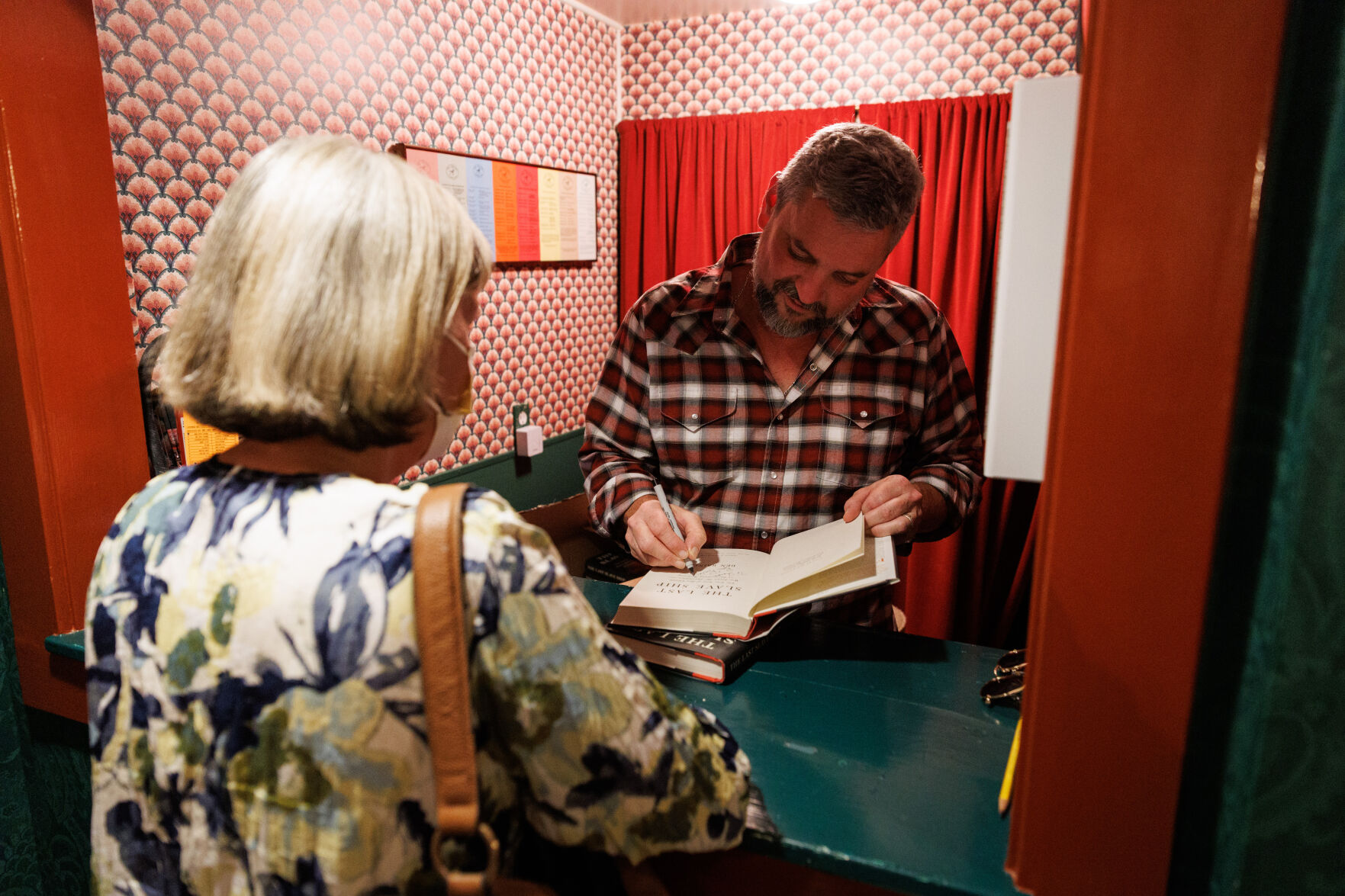If not for Ben Raines, the world wouldn’t know one of the most dramatic stories of the last 163 years.
In 2018 upriver from Mobile, Ala., this former journalist discovered the wreck of Clotilda, the last slave ship to reach our nation.

Moment of discovery
Author/filmmaker Ben Raines recovers a shard of America’s last slave ship, the Clotilda.
Raines told his riveting tale to Rappahannock residents on Sept. 16, bringing it back to the county where he graduated from high school and learned to fly fish decades ago.
Tim Carrington, a board member of the Rappahannock Association for Arts and Community(RAAC), introduced the author, noting how Raines succeeded where others had failed to deduce the Clotilda’s long-hidden resting place.Raines dove into the Mobile River to determine if he had the right wreck.
“He came up with a piece of burnt wood that opened a window on our own history and on a particular and strange chapter of the harrowing story of plantation slavery in the Southern states,” Carrington said. “Had he not done this, the story of the Clotilda … might have been swept aside or glossed over with simplicities. So, thank you, Ben, for asking the vital question of what really happened.”
Carrington thanked photographer Susan Raines, head of the Middle Street Gallery and Ben’s mother, for “summoning her offspring” to share his insights with folks where he grew up.
Raines, who lives in Fairhope, Ala., wrote 2022’s “The Last Slave Ship,” a New York Times’ “Editor’s Choice” now in paperback. He illustrated his Little Washington Theatre talk with photos from his adventures.
A filmmaker and charter captain in “America’s Amazon,” the Mobile-Tensaw River Delta, Raines dug into records and discarded historical myths to find the Clotilda’s grave.
She was right where her captain, upon offloading her human cargo after a 45-day voyage across the Atlantic, burned and scuttled the schooner in 1860–eve of the Civil War–to conceal the crime. The United States had banned importing Africans 50 years before; President Thomas Jefferson signed the bill into law.
Word of the wreck’s discovery made international news.
Watch the 60 Minutes story:
The Clotilda’s saga began with a bet. Mobile steamboat magnate Timothy Meaher wagered $30,000 in today’s dollars that he could send a ship to Africa, buy slaves there and return safely to Mobile. If caught, the punishment was hanging.
To pull it off, Meaher hired William Foster, a ship captain whose payment would be 10 of the captives. The 110 Africans that Foster brought to Mobile were worth the equivalent of about $5 million today.
The Clotilda’s best-known passenger, Cudjo Lewis, was abducted at 19 and lived until 1935. Long presumed to be the Middle Passage’s last survivor, Lewis appears today in movie clips and folklorist Zora Neale Hurston’s best-selling “Barracoon.” His descendants still live in Africatown, the community Lewis and his shipmates built in Mobile after emancipation.
Raines described his travels to Benin, Africa, where the pre-colonial kingdom of Dahomey enslaved 1 million other Africans, selling them to European traders over 200-plus years. Statues and murals along Benin’s Slave Route now commemorate the victims.
When Raines piloted Benin’s U.S. ambassador to the Clotilda wreck site, it moved the man to tears. It turned out, ancestors of the diplomat’s father had enslaved his mother’s ancestors.
“Here was the story in one man, reduced to sobbing on my boat,” the author recalled.
Benin’s leaders — worried about tribal civil war — decided decades ago to confront its dark past. “We’re not hiding from it,” its president said on a visit to Baltimore in the 1990s. Kneeling in church there, he apologized for the African role in the slave trade.
In Mobile, once freed, the Clotilda’s passengers bought land from the Meahers and built houses for one another. By the 1950s, Africantown had 12,000 residents, with theaters, grocery stores, barber shops, schools and restaurants.
Today, no businesses are left.
The Meaher family leased and sold much of its land in Africatown to heavy industry; International Paper built the world’s largest paper mill there. A new highway tore the community in half, destroying its business district and many residents’ homes.

ben raines book signing
Ben Raines signs copies of his book at the Little Washington Theatre.
Several weeks ago, Africatown opened the first museum devoted to the Clotilda. It’s about the size of Little Washington’s theater, Raines said.
“It’s a great first start,” he said. “But it’s not what we have in mind.”
Raines and Africatown’s leaders want to build a world-class museum that serves as a national monument to the enslaved, houses the wrecked ship and tells about those smuggled aboard it.
Like Benin’s public art, the Clotilda’s story helps represent all the anonymous, faceless people who were sold into bondage, Raines said.
“We read about slavery, (but) it’s anonymous, it was so long ago, and we don’t know anything about ’em,” he said. “This puts a face on slavery. We can see who the villains are and we can hear the story of the captives from their own mouths. That’s the power of the story.”
LEARN MORE: theclotildastory.comfacebook.com/ben.raines.58
Clint Schemmer, a former editor at the Culpeper Star-Exponent and The Free Lance-Star, lives in Fredericksburg.





